Basis Vectors
We often graph vectors in an xy-coordinate system, where we can talk
about vectors in purely numerical terms. For instance, the vector
(3,4) is the vector whose tail is at the
origin and whose tip is at the point (3,4)
on the coordinate plane. From this coordinate, you can use the Pythagorean
Theorem to calculate that the vector’s magnitude is
5 and trigonometry to calculate that its
direction is about 53.1º above the x-axis.
Two vectors of particular note are (1,0), the vector of magnitude 1 that points
along the x-axis, and (0,1), the
vector of magnitude 1 that points along the
y-axis. These are called the basis vectors and are written with
the special hat notation:
 and
and
 respectively.
respectively.
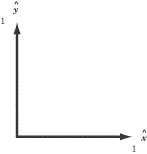
The basis vectors are important because you can express any vector
in terms of the sum of multiples of the two basis vectors. For instance, the vector (3,4)
that we discussed above—call it A—can be expressed as the vector sum
 .
.
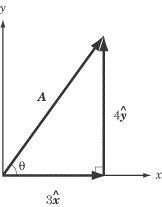
The vector3  is called the
“x-component” of A and the 4
is called the
“x-component” of A and the 4  is called the
“y-component” of A. In this site, we will use subscripts to denote vector components.
For example, the x-component of A is Ax and the y-component of vector A is Ay .
is called the
“y-component” of A. In this site, we will use subscripts to denote vector components.
For example, the x-component of A is Ax and the y-component of vector A is Ay .
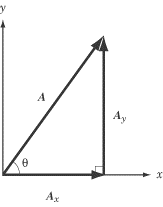
The direction of a vector can be expressed in terms of the angle ?
by which it is rotated counterclockwise from the x-axis.
Vector Decomposition
The process of finding a vector’s components is
known as “resolving,” “decomposing,” or “breaking down” a vector.
Let’s take the example, illustrated above, of a vector, A, with a
magnitude of A and a direction ? above the x-axis. Because Ax ,Ay and A
form a right triangle, we can use trigonometry to solve this problem.
Applying the trigonometric definitions of cosine and sine,

we find:

Vector Addition Using Components
Vector decomposition is particularly useful when you’re
called upon to add two vectors that are neither parallel nor perpendicular.
In such a case, you will want to resolve one vector into components that run parallel
and perpendicular to the other vector.
Example
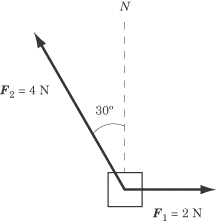
Two ropes are tied to a box on a frictionless surface.
One rope pulls due east with a force of 2.0N. The second
rope pulls with a force of 4.0N at an angle 30º west of north,
as shown in the diagram. What is the total force acting on the box?
To solve this problem, we need to resolve the force on the second
rope into its northward and westward components.
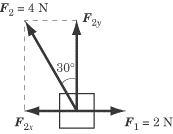
Because the force is directed 30° west of north, its northward component is

and its westward component is

Since the eastward component is also 2.0N, the eastward
and westward components cancel one another out. The
resultant force is directed due north, with a force of approximately 3.4N.
approximately 3.4N.
You can justify this answer by using the parallelogram
method. If you fill out the half-completed parallelogram formed
by the two vectors in the diagram above, you will find that the opposite corner of the parallelogram
is directly above the corner made by the tails of those two vectors.
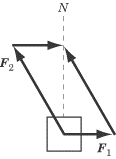 Back
Next
Back
Next
Next to display next topic in the chapter.
Practice Questions
Video Lessons and 10 Fully Explained Grand Tests
Large number of solved practice MCQ with explanations. Video Lessons and 10 Fully explained Grand/Full Tests.